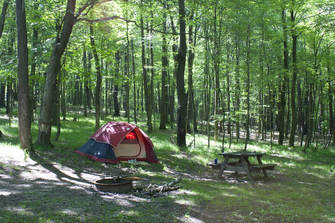|
by Gerald Rowan Every now and then some hikers get the urge for a road trip—a “getaway from our home turf and into new territory” kind of a trip. Raccoon Creek State Park was a jumping-off point for one of those trips—our “exploring the west” trip. We planned to start in the southwest part of the state and head northeast into the wilds of Pennsylvania. This was to be a hiking, backpacking, and car-camping trip using a number of state parks as our base of operations. We started at Raccoon Creek State Park and worked our way through Keystone, Linn Run, Laurel Ridge, and Laurel Mountain State Parks followed by Blue Knob, Trough Creek, and Colonial Denning State Parks. The entire trip was to be a month long. We intended to include Canoe Creek and Black Moshannon State Parks in our schedules but ran out of time.
Raccoon Creek State Park, in Beaver County between the Ohio River and the West Virginia state line, is large as far as Pennsylvania state parks go. Plus it offers a variety of amenities, including electric and nonelectric campsites as well as cabins. There’s a lake with a bathing beach and, of course, Raccoon Creek. A shower house and a dump station round out the amenities. Both geology and geography make the area interesting. Horizontal strata of both hard and soft rock layers make up the area. The creek and its tributaries have cut the strata deeply, forming numerous rock overhangs and waterfalls as the softer rock layers weather faster than the harder layers. One of those layers contains chert, the first cousin of flint and an important material for early humans to produce tools and weapons. The stream, the protection of the rock shelters, and the availability of chert made the area a place of congregation for some of the earliest settlers to this continent. One particular spot, about 15 miles from the park, is the Meadowcroft Rock Shelter, which archaeologists regard as the longest-occupied site in the Americas. People began camping at the shelter 16,000 years ago and, according to archaeologist Jim Adovasio of Mercyhurst University, used the shelter as a sort of late Pleistocene “Holiday Inn” until the 13th century. The large overhang, good ventilation, and presence of Cross Creek only several feet below the shelter’s opening helped make the site appealing. The long-ago collapse of the ledge overhang was akin to closing a book on the archeological past of the area. That book remained closed until 1955, when archeologists began excavating the site. What they found was not just a book but a whole library of artifacts from the dawn of human occupation in North America. The pre-Clovis artifacts from the shelter include a lanceolate point, bifaces, unifaces, prismatic blades, and core fragments. Renovations were made to the shelter in 2008 so that visitors could see some of the tools and campfires made by the first Americans thousands of years ago. The shelter is recognized as a Pennsylvania Commonwealth Treasure and is an official project of the National Park Service’s Save America’s Treasures program. A re-creation of a 17th-century Native American village is under development. With the shelter so close by, we were keen to see it. We headed off early in the day to see the excavations, have a picnic lunch, and do some hiking along Cross Creek. A moment to imagine: being back 16,000 years ago, harvesting chert and making spear- and arrowheads. Imagine hunting and gathering wild food on the small floodplain of the creek. Was the climate just postglacial, or was it similar to today’s? An objective of our trip was not only hiking some new trails but taking in any new experiences and interesting stuff along the way. We spent 3 days at Raccoon Creek—hiking some of the 45 miles of park trails on the first day, exploring the Meadowcroft Rock Shelter on the second day, and hiking and exploring the old health spa at Frankfort Mineral Springs on the final day. Then we moved on to Keystone State Park. With a 2-man kayak on top of the truck and fishing gear stowed behind the seat, we were ready for anything. We could camp, backpack, hike, fish, kayak, swim, or just be tourists as the mood struck us. After at least 60 years of hiking and backpacking, I find that just bagging miles is no longer as important as it once was. There is much more to experience and enjoy than just the miles. There is a lot of Pennsylvania to encounter along the way—from outdoor chamber music performances to church dinners and picnics, swimming holes, lakes for fishing, and streams for kayaking. When planning trips, I design them with flexibility in mind. Imagine a month with the time to follow a loose schedule of hiking destinations while enjoying any interesting side trips along the way. Deciding in the moment when to fish, when to hike, when to kayak. Among our more notable side trips was to Forbes State Forest, where we visited Mount Davis, the state’s highest point at 3,213 feet. We climbed the tower, hiked the trails, and kayaked on High Point Lake. A line of thunderstorms had passed through the area just before we arrived at Forbes, leaving the air dry and clean, the sun sparkling. The high elevation made the nights comfortably cool, so the sleeping was great. We didn’t get to Canoe Creek and Black Moshannon State Parks, making those parks logical starting places for our next adventure. Maybe that trip should be a fall trip. Here’s a recipe I wanted to share for your next hiking or camping trip: Trail Potato Bread 1½ cups all-purpose flour, plus more for dusting 2 teaspoons baking powder 2 tablespoons cold bacon fat or butter, cubed ¾ cup instant mashed potato flakes 2 tablespoons dry milk powder ¾ cup water (adjust if needed; different brands of flour and instant mashed potatoes absorb differing amounts of water to form a dough) Bacon fat, butter, or vegetable oil for frying Kosher salt, to taste At home, combine the flour, potato flakes, baking powder, milk, and salt and mix well. Store in a ziplock bag. In camp, add the bacon fat or butter, cubed, to the bag and knead until the mixture looks like coarse meal. Add the water and work the mixture into a dough. Divide the dough into 6 balls; then pat into a flat bread about 3/16-inch thick. Add some bacon fat, butter, or vegetable oil to a skillet and heat over a medium fire. Add the flat bread, 1 piece at a time, and sauté until browned on both sides. Great with chili or instead of toast with breakfast. Substitutions: 1½ cup self-rising flour for the all-purpose flour and baking powder; 1 teaspoon baking soda for the baking powder; ¾ cup buttermilk for the water. Additions: 1 green onion, finely chopped and added to the dough; ½ teaspoon garlic powder.
0 Comments
Your comment will be posted after it is approved.
Leave a Reply. |
Categories
All
Archives
July 2024
Keystone Trails AssociationSubmissions welcome! |
Sign up for our newsletter: |
|
Learn |
Contact |
|

 RSS Feed
RSS Feed
